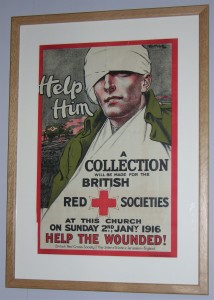
Help the Wounded poster from the Great War. Designed by Tom Purvis. Wellcome Collection, London, England.
(P. Ferguson image, November 2008)
The Math is Staggering
The Home Front has returned. Mobilized now to fight an invisible enemy the need is great. Like those who gathered materials for two world wars they work…long days… with heart, dedication, love, concern.
During the Great War those on the home front accepted linens, cottons, flannels and blankets to be re-purposed, turned into other things. Bed-sheets became slings, bandages, wash cloths. They made mouth wipes, face cloths, towels.
The carnage these dedicated souls faced was unprecedented. In August 1914 it was estimated the home front should prepare for 60,000 wounded per week. The war lasted just over 51 months…almost 223 weeks…the math is staggering.
A generation later unprecedented carnage would resurface again and the home front volunteers mobilized. They too would make do and mend, they read the posters that implored coughs and sneezes spread diseases…the need was great and the need is great again.
Private Arthur Edward Pitman
Royal Army Medical Corps
Awarded the British Empire Medal
This private was a prisoner of war in Thailand. During the Cholera epidemic in the Summer of 1943, he did marvelous work. He nursed hundreds of cholera cases quite fearlessly, washed fed and cleansed them without any regard for his own safety, in the most indescribably filthy conditions. He was always cheerful, worked tirelessly and must at times have gone for days without sleep. Mere words cannot do justice to the work he carried out or the fine example he set, and by his personal care many lives were saved.
Tags: Arthur Edward Pitman, British Empire Medal, Cholera, COVID-19, Home Front, Prisoner of War, Royal Army Medical Corps
This entry was posted by pferguson
on Thursday, April 2nd, 2020 at 7:24 pm and is filed under Inspired By a True Story.
You can follow any responses to this entry through the RSS 2.0 feed.
You can leave a response, or trackback from your own site.
About The Author

Paul has worked with the Paradigm Motion Picture Company since 2009 as producer, historian and research specialist. Paul first met Casey and Ian WIlliams of Paradigm in April 2007 at Ieper (Ypres), Belgium when ceremonies were being held for the re-dedication of the Vimy Memorial, France.
Paul's sensitivity to film was developed at an early age seeing his first films at RCAF Zweibrucken, Germany and Sardinia. Paul returned to Canada in 1967 and was captivated by David Lean's "Lawrence of Arabia" and "Bridge on the River Kwai". Over time Paul became increasingly interested in storytelling, content development, character, direction, cinematography, narration and soundtracks.
At the University of Victoria, Paul studied and compared Japanese and Australian film and became interested in Australian film maker Peter Weir and his film "Gallipoli" (1981). Paul was inspired when he learned Weir visited the beaches, ridges and ravines of the peninsula. "Gallipoli", the film, led Paul on many journeys to sites of conflict in England, France, Belgium, Holland, Germany, Malta, Hawaii, Gallipoli, North Macedonia and Salonika.
When Paul first watched documentary filmmaker Ken Burns, "The Civil War", Paul understood how his own experience and insight could be effective and perhaps influential in film-making. Combining his knowledge of Museums and Archives, exhibitions and idea strategies with his film interests was a natural progression.
Paul thinks like a film-maker. His passion for history and storytelling brings to Paradigm an eye (and ear) to the keen and sensitive interests of; content development, the understanding of successful and relational use of collections, imagery and voice. Like Paul's favorite actor, Peter O'Toole, Paul believes in the adage “To deepen not broaden.”
While on this path Paul always remembers his grandmother whose father did not return from the Great War and how his loss shaped her life and how her experience continues to guide him.


Comments